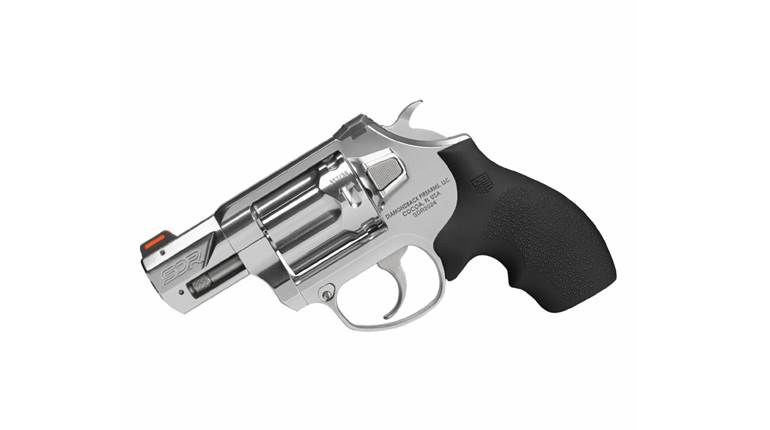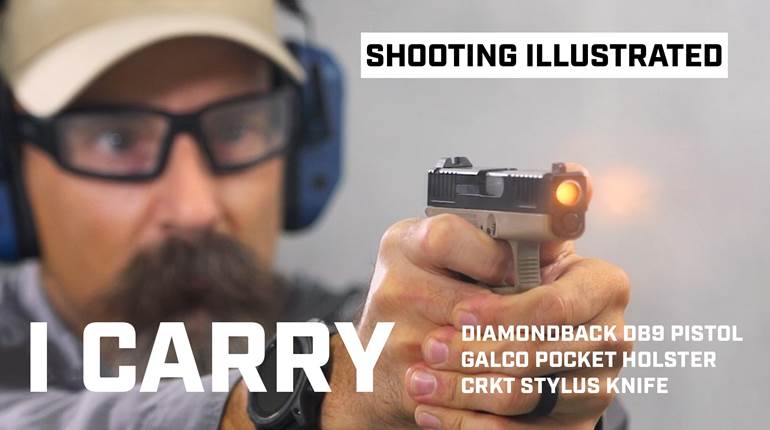
The Diamondback DB380 is a new, innovative pocket pistol in the popular .380 ACP chambering produced by Diamondback Firearms of Cocoa, Fla. The diminutive DB380 is a locked-breach, recoil-operated, double-action only, striker-fired semi-automatic with a six-round magazine. Dual nested recoil springs inside the slide help ensure reliability. At only 8.8 ounces, it is one of the smallest striker-fired micro-compact pocket guns currently available.
The DB380’s “zero-energy” striker firing system also distinguishes this gun. The action of the Diamondback’s slide does not partially cock, or pre-load, the striker; instead the trigger does all the work, resulting in a trigger pull heavier than pre-loaded, striker-fired guns. That said, compared to that of other double-action-only pistols, the pull on the test gun measured a relatively light 6 pounds, 8 ounces. It should be noted that the trigger does not reset unless the slide is retracted.
As the DB380 has no manual safety, the slightly heavier trigger pull may be considered a benefit. Another advantage to this system is that there is no energy stored in the striker, so there is less chance that the firing pin may be driven forward accidentally. The pistol also features a firing pin block that helps prevent the gun from discharging unless the trigger is completely depressed.
The frame is glass-reinforced polymer, and the barrel and the slide are made from 4140 steel billet. The magazine catch, trigger and rails are chrome-moly steel and black-oxide coated. The trigger parts and the standard black-colored slide are Melonite-treated for extra hardness and durability. Slides come in three options: melonite, nickel and EXO (tested).
The optional EXO coating is a nickel-boron surface treatment that provides a natural lubricity, dissipates heat and hardens the surface of the slide to improve ease of cleaning while improving wear and corrosion resistance.
The DB380 has a number of features that make it appropriate for pocket carry. The diminutive but very usable three-dot-pattern sights are snag-free, and the rear sight is drift adjustable. The closed design in the back of the gun helps reduce the accumulation of pocket lint, and the low-profile magazine catch help s prevent unintentional ejection of the magazine. The slide is also nicely scalloped, front and rear, to provide an effective grasping surface. All of the sharp angles have been smoothed out as well.
The deeply recessed backstrap of the DB380 allows the shooter to gain a higher hold on the grip, placing the hand more in line with the axis of the barrel. Even those with large hands could secure two full fingers onto the checkered frontstrap. A better grasp results in less perceived recoil and better control of the gun for faster follow-up shots. Slight right and left thumb rests provide good memory pads for the hands as well. A prominent beavertail at the back of the grip also helps secure a high grip without interfering with the slide operation. Operation and disassembly are fairly straightforward and similar to the Glock series of pistols.
On the range the ergonomic characteristics of the Diamondback DB380 were readily apparent, and given its small size and narrow grip it was still an easy gun to shoot well with low perceived recoil compared to other similar-sized .380 ACP pocket guns. After 50 rounds the DB380 remained, if not pleasant, at least comfortable enough to shoot, but shooting more than 100 rounds a session taxed the endurance of our test shooters. As a small pocket gun it is not intended for extended range time.
The factory sights are set at the 6 o’clock position, and at 7 yards bullets impacted approximately 2 inches below point of aim. Shooting from a rest at 25 yards produced groups about 10 inches below the point of aim. Through two range sessions a few malfunctions occurred, resulting in four failures-to-feed using hollow-point ammunition and three failures-to-feed using full-metal jacket ammunition. All of these malfunctions occurred early in our range session.
Although the Diamondback did not seem to prefer one type of ammunition over another, it did provide exemplary accuracy. The smallest group at 7 yards measured an impressive 0.70 inches with Black Hills ammunition.
The growing popularity of concealed carry has singlehandedly revived the once-maligned pocket gun and the .380 ACP cartridge. American shooters are now blessed with a surfeit of choices in this chambering, and the variety and quality of defensive loads in this caliber has improved dramatically. The Diamondback DB380’s compact size and light weight make it an easy gun to have at the ready at all times.
Specs:
Manufacturer: Diamondback Firearms, LLC; diamondbackfirearms.com
Caliber: .380 ACP
Action Type: double-action, semi-automatic, center-fire pistol
Frame: polymer
Barrel: 2.8"
Rifling: six-groove, 1:16" RH twist
Magazine Capacity: six
Sights: white three-dot, rear drift-adjustable
Trigger Pull: 6 lbs., 8 ozs.
Overall Length: 5.24"
Width: 0.75"
Height: 3.77"
Weight: 8.8 ozs.
Accessories: plastic case, trigger lock
Suggested Retail Price: $430






































